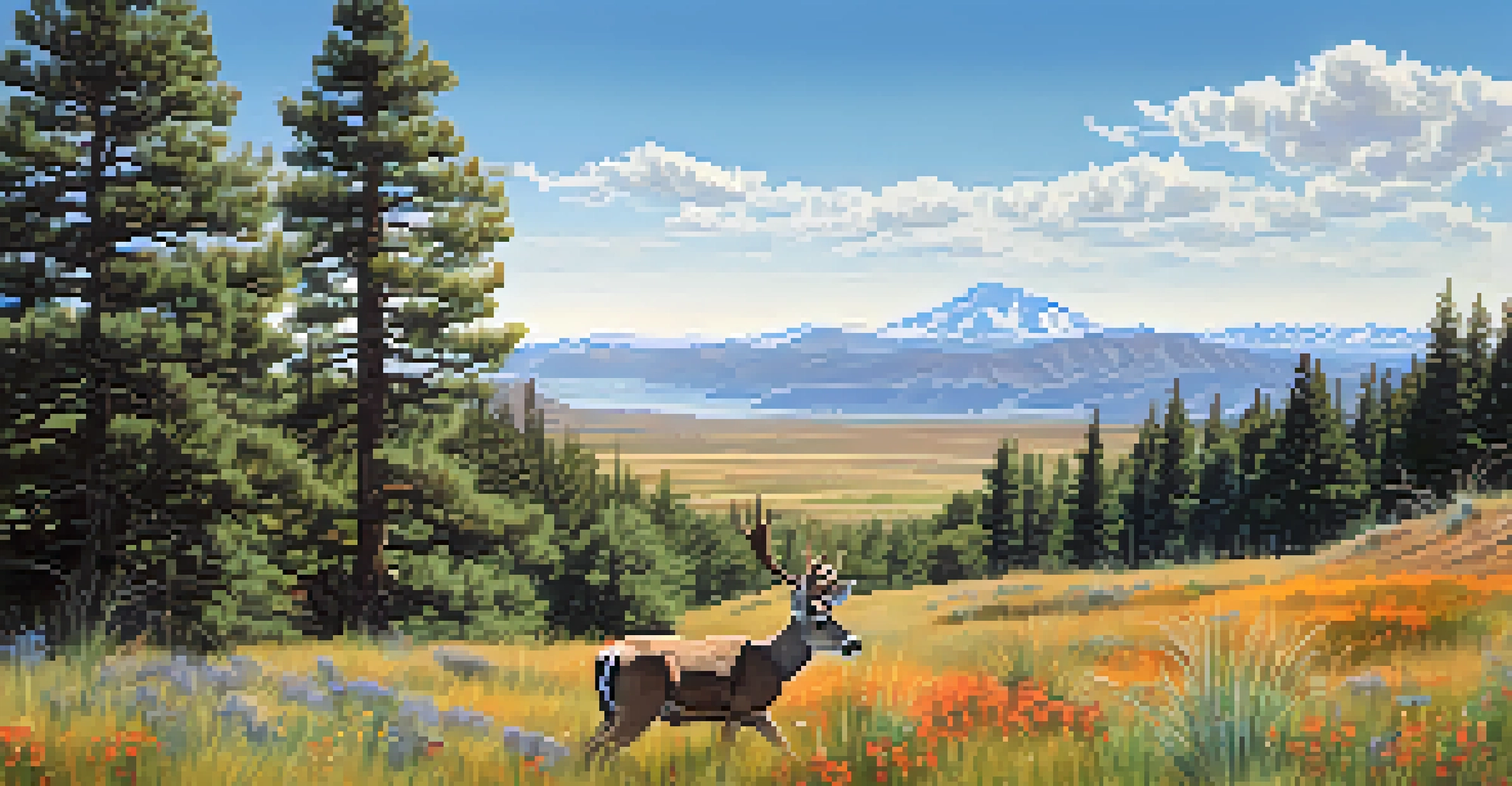The Role of Elevation in Utah's Diverse Climate Zones

Utah's Geographic Diversity: An Introduction
Utah is a state renowned for its stunning landscapes, ranging from towering mountains to expansive deserts. This geographic diversity is largely influenced by elevation, which varies dramatically across the state. In fact, Utah's elevation ranges from around 2,000 feet in the Great Salt Lake to over 13,500 feet at the summit of Kings Peak. As we delve deeper, we'll uncover how these elevation changes create distinct climate zones throughout Utah.
The mountains are calling and I must go.
Understanding these variations is crucial not only for residents but also for visitors who wish to experience Utah's natural beauty. Each elevation level hosts unique ecosystems, flora, and fauna, contributing to the state’s rich biodiversity. By exploring these different climate zones, we can appreciate how elevation impacts weather patterns, plant growth, and wildlife habitats.
In this article, we’ll navigate through Utah’s diverse climate zones, examining the role elevation plays in shaping everything from temperature to precipitation. Whether you're an outdoor enthusiast or a curious traveler, knowing how elevation influences Utah’s climate will enhance your appreciation of this incredible state.
Lowland Deserts: The Warmth of the Basin
In the lower elevations of Utah, particularly in the Great Basin region, you'll find arid desert climates. These areas typically sit below 4,500 feet and experience hot summers and mild winters. The unique combination of high evaporation rates and low precipitation results in a stark landscape with sparse vegetation. Here, you’ll encounter iconic species like sagebrush and desert wildflowers that have adapted to survive in such harsh conditions.

One of the most notable ecosystems in this elevation zone is the Utah desert tortoise habitat. This remarkable creature has adapted to the dry climate, showing just how resilient life can be. Despite the seemingly inhospitable environment, the lowland deserts are teeming with life, although it may be less visible than in other areas.
Utah's Climate Shaped by Elevation
The diverse climate zones in Utah are significantly influenced by varying elevations, impacting ecosystems and weather patterns.
Moreover, the climate in these regions can vary significantly from day to night, with temperatures dropping sharply after sunset. This drastic temperature fluctuation is a hallmark of desert climates and contributes to the unique survival strategies of the plants and animals that call this zone home.
The Transition Zone: Elevation's Middle Ground
As we move up in elevation, we enter what is often referred to as the transition zone, typically between 4,500 to 7,500 feet. This area showcases a blend of desert and mountainous climates, leading to diverse ecosystems. The temperatures here are cooler, with increased precipitation compared to the lowland deserts. This region is characterized by pine forests, shrublands, and a variety of wildlife, making it a vital habitat for many species.
In every walk with nature one receives far more than he seeks.
Here, you’ll find animals like mule deer and wild turkeys thriving among the pines, and the diverse plant life includes various conifers and wildflowers. This mix of ecosystems supports a rich array of biodiversity, resulting in a beautiful tapestry of life. The transition zone serves as a critical buffer between the harsher desert environments and the cooler mountain climates.
Moreover, this zone is particularly popular for outdoor activities such as hiking and camping, allowing visitors to experience the beauty of Utah’s diverse landscapes. It’s a perfect reminder of how elevation influences not just the climate, but also the recreational opportunities available to residents and tourists alike.
Mountain Climate: Cool and Moist Conditions
As we ascend to elevations above 7,500 feet, we encounter the mountainous climate zones, characterized by cooler temperatures and higher humidity. This area is home to Utah's iconic Wasatch Range and other prominent mountain ranges. The climate here supports lush forests, alpine meadows, and vibrant ecosystems, creating a stark contrast to the arid lowlands below. In winter, these regions receive significant snowfall, making them a haven for skiing and snowboarding enthusiasts.
This mountainous climate is essential for Utah's water supply, as the snowpack melts in the spring, feeding rivers and reservoirs. The importance of high-elevation ecosystems cannot be overstated, as they play a crucial role in maintaining the overall health of the state's environment. The unique flora, including wildflowers and conifer trees, thrives in this cooler climate, supporting a variety of wildlife.
Unique Ecosystems at Different Elevations
Each elevation level in Utah hosts distinct ecosystems, from arid deserts to lush mountain forests, showcasing rich biodiversity.
Additionally, the dramatic elevation changes create microclimates within the mountainous regions, influencing everything from plant growth to animal behavior. These variations result in an ever-changing landscape that captivates anyone exploring Utah's high country.
The Great Salt Lake: A Unique Climate Influence
The Great Salt Lake, located at a low elevation of about 4,200 feet, plays a distinctive role in Utah's climate. Its vast, shallow waters create a localized climate that influences surrounding areas, particularly in terms of humidity and temperature. The lake's high salinity affects evaporation rates and precipitation patterns, creating a unique ecosystem that differs from other lowland desert regions.
Birdwatchers and nature enthusiasts flock to the Great Salt Lake to witness its diverse avian populations, including migratory birds that rely on the lake's resources. The surrounding wetlands and marshes contribute to a rich habitat, illustrating how a body of water can significantly impact local climate and biodiversity. The unique conditions fostered by the lake are a testament to the intricate relationship between elevation, geography, and climate.
Interestingly, the lake's influence extends beyond wildlife; it also affects local weather patterns, occasionally leading to localized storms. Understanding the Great Salt Lake's role in Utah's climate helps us appreciate the state's ecological complexity and the importance of preserving such unique environments.
Climate Change: Elevation's Role in Resilience
As climate change continues to impact ecosystems globally, Utah's varied elevation levels play a crucial role in ecological resilience. Higher elevations often act as refuges for certain species, providing cooler microclimates that can help mitigate the effects of rising temperatures. This adaptability is vital for maintaining biodiversity as species seek suitable habitats in response to changing conditions.
Conversely, lower elevation areas are more susceptible to extreme heat and drought, which can threaten ecosystems and the species that inhabit them. Understanding how elevation influences climate resilience allows conservationists to develop effective strategies for protecting vulnerable species and habitats. It highlights the importance of considering elevation in climate change discussions and conservation efforts.
Elevation's Role in Climate Resilience
Higher elevations provide cooler microclimates that help species adapt to climate change, highlighting the importance of elevation in conservation.
Ultimately, recognizing the role of elevation in Utah's climate zones is essential for promoting sustainable practices that protect the state's unique ecosystems. By fostering a deeper understanding of how elevation influences climate, we can better equip ourselves to address the challenges posed by climate change and preserve Utah’s natural beauty for future generations.
Conclusion: Elevation's Lasting Impact on Utah's Climate
In conclusion, Utah's diverse climate zones are a fascinating testament to the impact of elevation. From the arid lowlands of the Great Basin to the lush mountain ranges, each elevation level contributes to a unique ecosystem. Understanding these variations is crucial for appreciating the state's natural beauty and the intricate web of life that exists within it.
As we continue to explore and enjoy Utah’s stunning landscapes, it’s essential to recognize the delicate balance between elevation, climate, and biodiversity. This knowledge not only enriches our experiences but also fosters a sense of responsibility toward protecting these precious ecosystems. The role of elevation in shaping Utah’s climate is a topic worth exploring further, as it holds the key to understanding our environment.

By embracing this understanding, we can advocate for sustainable practices that preserve Utah’s natural heritage. Elevation is more than just a number; it’s a defining factor in the rich tapestry of life that makes Utah a truly remarkable place.